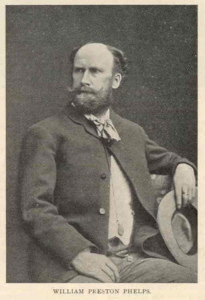William Preston Phelps was a fine American painter who found his greatest inspiration in the landscapes of his native New Hampshire. After a modest beginning as a sign painter in 1875, he held his first exhibition in Lowell, Massachusetts. Several area businessmen reacted to this exhibition by purchasing paintings and assembling a fund which enabled Phelps to have European study and training. From 1875 through 1877 he was in Munich where he became a well known member of the American contingent of art students.
After a brief return to the United States in 1878, during which he exhibited for the first time at the National Academy of Design, Phelps returned to Europe. Once again in Munich, he became a cofounder of the Munich Art Club along with Walter Shirlaw, David Neal, Frank Duveneck, and William Merritt Chase. This second time in Europe lasted five years and was divided into three years in Munich and two in Paris. Upon his return to America, Phelps had a studio near Tremont Street in Boston where he associated with John J. Enneking, Alfred Ordway, and Benjamin Champney.
In 1890 he reacquired the family farm near Chesham, New Hampshire and thereafter worked prodigiously painting the area’s bucolic landscapes. Karl Gabosh, the main authority to research Phelp’s career has noted that “some of Phelp’s finest works are indeed of Monadnock,” and Ina Haywood, writing in the Introduction to the final 1917 Sales Catalogue of Phelp’s work noted that “he deservedly merits the appelation by which he is so often designated, the painter of Monadnock.” Another observer of Phelp’s work was Charles Hurd, who noted the importance of Mount Monadnock to the artist:
“Phelps, during a visit some 2-3 years before he reacquired his homestead, saw the mountain (Monadnock) through new eyes, and was to be excited and inspired by what he saw. Here were the things he had known from boyhood, which had grown into his soul, and which though they had laid dormant for years had awakened to vigorous life. From that moment he worked under the influence of a new inspiration. He studied the mountain with eyes of a lover. In sunshine and shadow, in storm and in calm he watched and noted and painted.”
Mount Monadnock from Stone Pond is among the finest known examples of Phelp’s work. It survives in excellent condition and exemplifies the fine technique and refined aesthetic sensibility that are the hallmarks of his best works.
Other fine examples of his may be seen in many corporate, private, and public collections including the West Point Museum, USMA, West Point, New York; Whistler House, Lowell Historical Society, Lowell, Massachusetts; William Benton Museum of Art, University of Connecticut, Storrs, Connecticut; the New Hampshire Historical Society, Concord, New Hampshire; and the Shelburne Museum, Shelburne, Vermont.
Signature
Photo Credit
Charles O. Vogel
Reference
Biographical information courtesy of Charles O. Vogel

